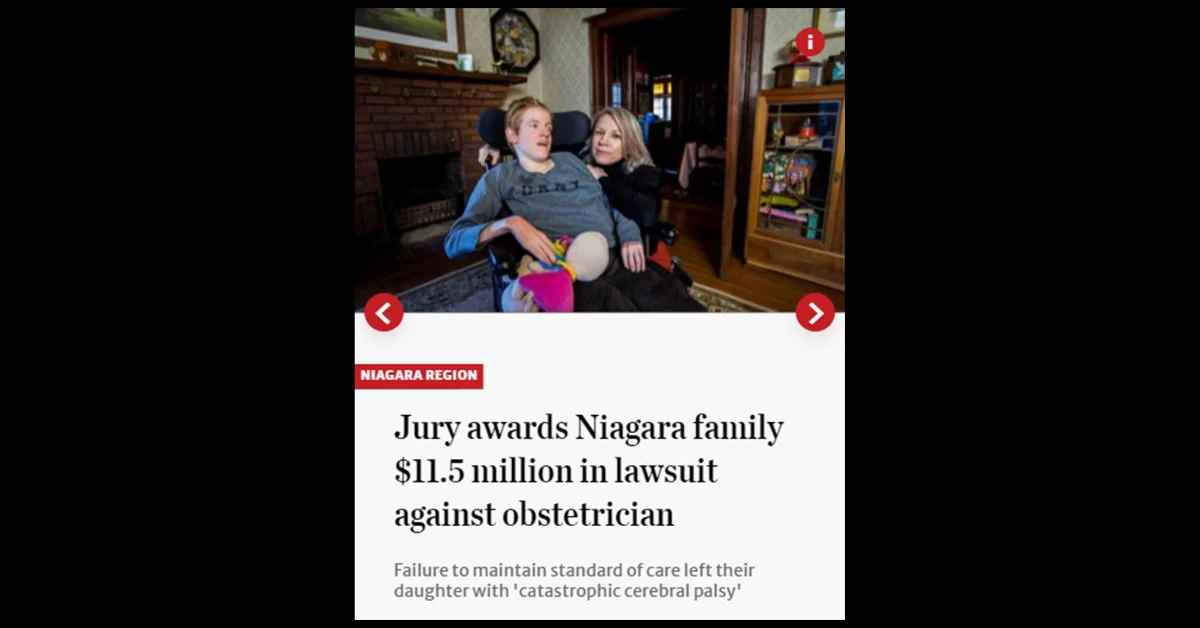
Ishac v Ontario (Health Insurance Plan) – Pectoral Implant Removal Not Covered by OHIP
In Ontario, the line between an insured health service and an elective cosmetic procedure can sometimes seem blurry. The Ontario Health Insurance Plan (OHIP) is

It was exactly four years today, on April 12, 2019, that medical malpractice lawyer Paul Cahill secured a jury verdict of negligence against a community obstetrician, Dr. Allan Jackiewicz for his substandard management of a high-risk twin pregnancy of twin to twin transfusion syndrome (“TTTS”) that tragically resulted in severe cerebral palsy for one of the twins.

After nearly a decade long legal battle that culminated into a 3 week jury trial, Kelsey Woods received justice for her catastrophic brain injury.
The physician, however, appealed the jury’s verdict to the Ontario Court of Appeal. On July 13, 2020, the Court of Appeal unanimously dismissed the doctor’s appeal upholding the jury’s verdict of negligence against the doctor.
THE TRIAL
Civil trials, especially in medical malpractice, are vigorously prosecuted and defended.
The physician is foremostly defending his reputation. Given that physicians are extremely well protected financially by their national defence association, the Canadian Medical Protective Association (“CMPA”), the doctor is virtually never personally on the hook for any judgment awarded if they are found negligent. They may however feel the reputational harm of such a finding and are therefore highly motivated to litigate these claims through to trial often with no offers to settle.
It was interesting that just before the start of this trial, the Defendant Dr. Jackiewicz had been found to be incompetent by the College of Physicians and Surgeons of Ontario (CPSO). By law, the jury was not made aware of this fact.
A patient’s primary motivation for the lawsuit is much different. More than anything they are seeking compensatory damages which is financial reimbursement for all the pain and suffering, lost income, and the cost of care that they have suffered and will suffer into the future because of their poor medical outcome at the hands of their doctor. In this case, it was agreed before trial that the financial compensation owed to Kelsey Woods and her family was $11.5 million, but they still had to prove the doctor was negligent to see any of it.
The jury did not know how much the case was worth throughout the trial. Nor the did the trial judge even. This was only disclosed after the conclusion of the trial.
This trial was fought on two fronts: the law and the facts. The legal issues were decided by the trial judge in the absence of the jury. A trial judge’s ruling on evidentiary issues can have a significant impact on the outcome of a case.
The facts, however, were solely decided by the jury based almost entirely on the testimony of various medical experts in the fields of obstetrics, perinatology, and pediatric neurology.
THE FACTUAL ISSUES
The Plaintiff, Ms. Booth was pregnant with twins in the early 1990s. She attended on the Defendant obstetrician for regular antenatal visits. On July 5, 1991, Ms. Booth saw Dr. Jackiewicz for an unscheduled appointment as she was experiencing severe abdominal pain and excessive weight gain.
Dr. Jackiewicz sent her home to rest. When the symptoms became worse, she went to Niagara Hospital on July 7 which arranged for her immediate transfer by ambulance to McMaster Hospital. By then, her cervix was two or three centimetres dilated. Doctors there delivered the babies by emergency C-section at 27 weeks into the pregnancy. As a result of the premature birth, one of the twins, Kelsey Woods, sustained brain damage.

One of the factual issues in this case was the measurement of symphyseal fundal height (“SFH”), and the fact that the defendant doctor had failed to measure this throughout the pregnancy except at the last visit. SFH is a measure of the size of the uterus used to assess fetal growth and development during pregnancy. It is measured from the top of the mother’s uterus to the top of the mother’s pubic symphysis. Fundal height, when expressed in centimeters, roughly corresponds to gestational age in weeks between 16 and 36 weeks for a vertex fetus.
One of the findings of negligence in the this trial was the fact that SFH was not measured or recorded until the last visit.
Probably the biggest issue at trial was factual causation, and specifically, what kind of treatment was available in 1991 for TTTS. There was a significant amount of evidence that suggested that there were limited treatment options for this condition with the exception of amnioreduction.

The defence position essentially was that amnioreduction was not widely available as a therapeutic option for this condition, and in fact, would not have been offered to the pregnant mother even if she as referred earlier to a perinatologist (an obstetrician who specializes in high-risk pregnancies).
A number of studies were entered into evidence which demonstrated various outcomes with amnioreduction, some of them being quite poor. The defence relied on these studies to try to prove that amnioreduction probably would not have made a difference even if it was available or offered at the time.
The causation theory of the Plaintiffs was that the twins were born prematurely by emergency c-section and that prematurity was the cause of the cerebral palsy. The longer the fetus can stay in the mother, the less likely it is to develop cerebral palsy.
TTTS, however, causes one twin to grow larger with a larger amniotic sac which can compress and harm the smaller twin with the smaller amniotic sac. The thinking behind amnioreduction at the time was that by removing the excess amniotic fluid from the larger twin, the smaller twin can remain healthy thereby avoiding the necessity of an emergency c-section and hence allowing more time for development. Amnioreduction would have significantly decreased the likelihood of brain damage and cerebral palsy for Kelsey.
THE LEGAL ISSUES
There were a number of motions argued during this trial of significant importance:
THE VERDICT

After deliberating for approximately a day and a half, the jury returned a verdict in favour of the Plaintiffs.
First, the jury was asked whether the Plaintiffs have proven on a balance of probabilities that there was a breach of the standard of care on the part of Dr. Jackiewicz. The jury answered this question in the affirmative and provided the following particulars of negligence against the doctor:
In a civil jury case, it is not sufficient for the patient to prove that the doctor erred. It must also be proven that the medical error caused harm to the patient.
Having determined that the doctor was negligent, the jury was then asked to decide whether the Plaintiffs had proven on a balance of probabilities that but for the breach of the standard of care Kelsey would not have sustained brain damage.

On the issue of causation, the jury decided that Kesley’s brain damage, in the form of cerebral palsy, was caused by the negligence of the obstetrician, Dr. Jackiewicz. With respect to the specific reasons why, they wrote: We recognize that the breach of the standard of care may not be the sole exclusive, or entire cause of the brain damage. However, we do believe there is a causal link between the breach in standard of care and the brain damage. The breach is Dr. Jackiewicz’ failure to refer Ms. Booth to a perinatologist or consult a perinatologist on July 5th. In consequence,
As a result, the Plaintiffs were successful in their medical malpractice claim securing a judgment of $11.5 million in damages.
THE APPEAL
After losing at trial, the defendant obstetrician appealed the jury’s verdict to the Ontario Court of Appeal.
On July 13, 2020, the doctor’s appeal was dismissed and the jury’s verdict upheld.
The Ontario Court of Appeal quoted from some of the evidence in their decision:
Ms. Booth would have gone to McMaster Hospital, at least initially, had she been referred to specialists on July 5. The causation issues related to the availability of effective treatment for TTTS at McMaster Hospital at that time.
Dr. Barrett, an expert in management of twin pregnancies called by the respondents, testified that removal of excess fluid from the amniotic cavity was “not a complicated procedure” and that “[a]ny maternal-fetal medicine should do it.” He said it was first developed in the 1940s and became widespread in the 1980s and 1990s. If for some reason McMaster Hospital could not do it in order to treat TTTS, the patient could have been sent to Toronto for the procedure.
Dr. Barrett testified that in 40% of cases, this procedure would resolve the TTTS entirely, and allow the pregnancy to continue normally to term. In other cases, it would prolong the pregnancy, allow the twins more time to develop, and allow effective use of steroids. The use of the procedure would have immediate beneficial effect. Dr. Barrett testified that amnioreduction was a “standard” treatment of TTTS in 1991, noting, “We were doing it all the time and I think the evidence is pretty clear that we knew it got better results than doing nothing.” Dr. Barrett disagreed when it was suggested to him that the appellant’s expert Dr. Mundle would say that there was limited availability of amnioreduction, and that Ms. Booth would not have had the treatment if she had been referred to McMaster Hospital on July 5.
Dr. Barrett testified that TTTS develops rapidly and that the mother’s presentation on July 5 would have been materially different from her condition on July 7.
Dr. Barrett testified that had amnioreduction been performed on July 5, the pregnancy would have been prolonged by about 5 weeks, and in addition there was a further 40% likelihood that the TTTS would have resolved completely. According to other expert evidence, a five-week extension of the pregnancy would have avoided the brain damage.
Dr. Farine, another expert for the respondents, testified that in Hamilton “they did amnios all the time”, though he did not have direct knowledge of whether McMaster Hospital did amnioreduction to treat TTTS at the time. He testified that amnioreduction was generally used to treat pregnancies where the “baby had too much fluid on board”. When counsel put to him that Dr. Mundle would say that Ms. Booth would not have received amnioreduction if referred on July 5 or earlier because there was limited availability of amnioreduction in 1991, Dr. Farine disagreed. Dr. Farine responded,
[I]f you’re perinatologist and you have two hands, you can do an amniocentesis. So each one of the perinatologists and probably some of the generalist[s] in Mac could have done it… So in the 1991 there was no reason not to embark on it and it’s easy to do…
The appellant’s expert, Dr. Mundle, ultimately said that his “feeling” was that McMaster Hospital did not offer amnioreduction for TTTS at that time. He explained that when he arrived in Ontario in 1997, McMaster Hospital was not doing it. However, by 1997 laser treatment for this condition had become available and was a more effective treatment.
The appellant distinguishes withdrawal of amniotic fluid for diagnostic purposes, amniocentesis, and withdrawal of amniotic fluid in single-baby pregnancies where there is too much fluid, from amnioreduction to treat TTTS. He submits that neither Dr. Farine nor Dr. Barrett were able to opine as to whether this treatment for TTTS was available at McMaster Hospital on July 5, 1991. Dr. Farine was familiar only with the practices at his own hospital. Dr. Barrett came to Canada after 1991, and when asked if he knew whether McMaster Hospital was offering the treatment for TTTS, he responded, “I don’t know exactly. I wasn’t working there. … I would assume it could’ve – it would’ve been. It’s not a complicated procedure. Any maternal-fetal medicine should do it.”
The appellant argues that without evidence from someone at McMaster Hospital that amnioreduction was available there for treatment of TTTS, the respondents’ case on causation had to fail. He says this absence of evidence amounted to a fatal gap in the respondents’ case and made the jury verdict on causation unreasonable.
The appellant introduced expert evidence supporting his position, but the jury did not accept that evidence. Since the appellant challenges the jury verdict on the ground that it was unreasonable, the focus on appeal is on whether there was evidence which could support the jury’s decision.
MEDIA
On April 15, 2019, shortly after the trial verdict, the St. Catharines Standard reported “Jury awards Niagara family $11.5 million in lawsuit against obstetrician”. In this article, Ms. Booth, the mother of the twins is quoted saying:
“It is very difficult to win a medical malpractice suit in Ontario, and it would have cost us hundreds and hundreds of thousands of dollars in lawyer fees at $600 an hour,” Booth said. “We didn’t have the money so we agreed to share a portion if we won.”
On July 13, 2020, soon after the Ontario Court of Appeal threw out the doctor’s appeal, the St. Catharines Standard reported: “Appeals court upholds $11.1 million verdict against Niagara doctor for not maintaining proper standard of care”. In this article, Paul Cahill is quoted as saying:
“I would say the family is overjoyed with the result from the court and the decision to dismiss the physician’s appeal,” said their lawyer, Paul Cahill of the Toronto-area firm Will Davidson LLP. “They are very much looking forward to focusing on using the funds they will hopefully now receive to make Kelsey’s life better.”
In June, 2020, Paul Cahill was featured on Inside Medical Malpractice, a critically acclaimed podcast followed by lawyers, doctors, and other health professionals. In this episode, Chris Rokosh talked to Paul Cahill about this jury trial that was based on a 1991 pregnancy complicated by TTTS. The tragic outcome was a stat C section and brain damaged baby with cerebral palsy. This legal case was complicated by the obvious challenge of determining the standard of care nearly 30 years ago. Listen to learn Paul’s approach to jury trials, how he has learned to distill the facts to present a compelling, sensible story to guide jurors towards a common sense and just decision.

In Ontario, the line between an insured health service and an elective cosmetic procedure can sometimes seem blurry. The Ontario Health Insurance Plan (OHIP) is

On February 11, 2019, Bradley McKee stabbed his father, William McKee, to death. At the time of the stabbing, Bradley was 27 years old; he